Like most people, I manipulate objects with my hands every minute of every day giving it little to no thought. I used my fingers to type this post, I clicked on my mouse to add an image, I massaged a tight knot in my shoulder.
As an architectural designer, I use my fingers to feel. I touch textures and surfaces, and I know that each one adds a different mood and contributes to the atmosphere in a space.
There have been many times in my life when I have experienced memories without thinking about it, simply by touching something which felt familiar. When I feel a crack in a porcelain bowl, I run my fingers along it and I am returned to a memory of myself as a child, when I used a similar bowl with a similar crack. For a split second, I am almost able to smell my grandmother’s stew.
[The skin] is the oldest and the most sensitive of our organs, our first medium of communication […] Touch is the parent of our eyes, ears, nose, and mouth. It is the sense which became differentiated into the others, a fact that seems to be recognized in the age-old evaluation of touch as ‘the mother of senses’. — Ashley Montagu
I fear that these sorts of experiences will happen less and less with the increase in digital interfaces infiltrating our lives. With digital interfaces on the rise, we are indirectly flattening our capacity for emotional engagement.
Increasingly, our fingers will only tap and slide on glass surfaces, or worse, nothing at all. This is almost like a paleo diet rant — what kind of natural tasks were we built to do that involved similar forms of finger movements? I would say almost none. Granted, the tactile quality which I speak of carries a nostalgic undertone. A cracked bowl 20 years ago did not have the need to integrate software into its hardware. Its texture carried so much weight because it was true to its content; it was integral to its being.
On the other hand in today’s day and age, technology has grown to be such a fundamental part of our lives that hardware and software integration is increasingly becoming a prerequisite for a useful product.
Keys are becoming increasingly unnecessary.
I think the only place you would use an alarm clock these days is at a stock photography photo shoot.
Knobs and controls on stoves are becoming a thing of the past.
The conundrum is this: how do we learn to do that without sacrificing the sentimental quality of the product?
In Google’s Project Jacquard, conductive yarn will allow technology to merge seamlessly into the fabric that we don. In its video, these new smart clothes were portrayed as new kinds of touch screens for users to control their electronic functions by stroking on your jeans.
Although, to quote Fortune’s Stacey Higginbotham: “it’s probably bad news for people who like to wipe their hands dry on their pants.”
Google’s Project Soli took it one step further. There isn’t even a surface for users to interact with — all you will need is your hands. It is a new interaction sensor using radar technology, where you can control your devices without even touching them. Carsten Schwesig, design lead of Project Soli, said in the promotional video, “Imagine a button between your thumb and your index finger, and the button’s not there, but pressing this is a very clear action.” Soli fits into a chip, can be produced at scale and be built into everyday objects.
As you can see, this is not a problem that is limited to glass surfaces, or fabric when we talk about the future, or any textures at all. In Soli, one loses touch (of physical objects) entirely. Imagine moving into a world where you no longer have to touch anything? Given that the skin is our oldest medium of communication, I feel a lot of resistance towards this possibility. The question is, how willing are we to let technology invade our lives?
On the opposite end of the spectrum from Project Jacquard and Soli, there are products that attempt to add the tactile to technology. Palette is a modular control interface consisting of dials, buttons and sliders that allow creatives to do their work through physical touch rather than digital controls. In a way, one could say that this approach is retrogressive, but progressive at the same time.
Golden Krishna talks about our app-and-screen-obsessed society in his book, The best interface is no interface. In his book, he left us questioning our love for screen based solutions. Using automotive door-opening apps as an example, he argues that perhaps we are all blinded by our love for screens, and that these apps are actually not improvements to our lives.
We design user interfaces for touch all the time, but rarely do we consider the user experience of touch. From texture, to analog interaction, the future of user experience is more tactile than Gorilla glass; and touch screens may soon be a thing of the past.
